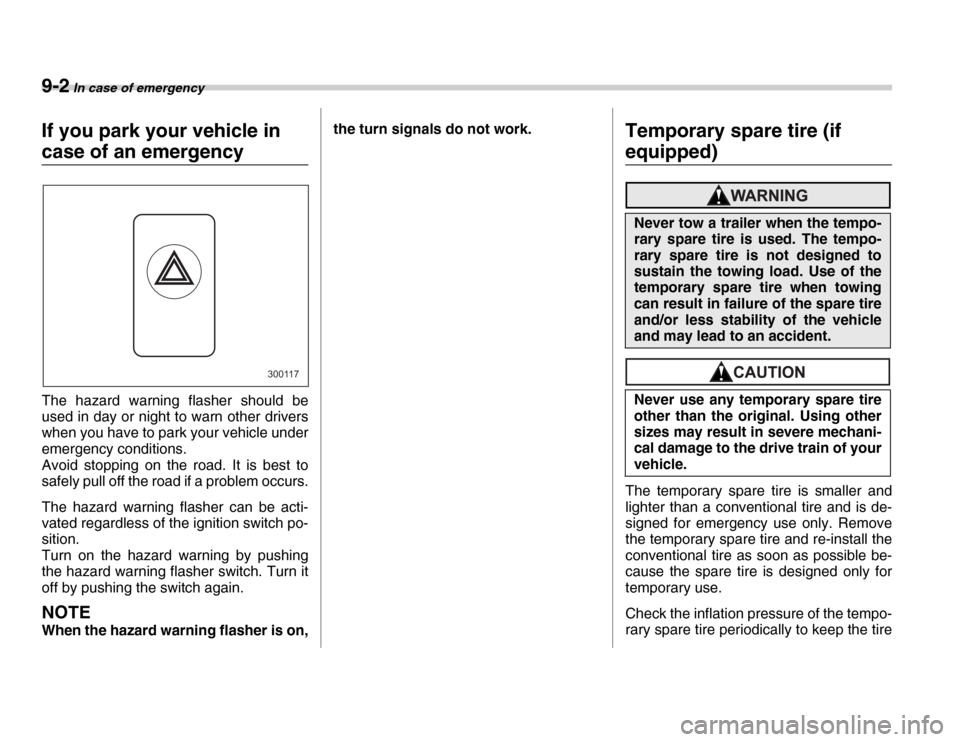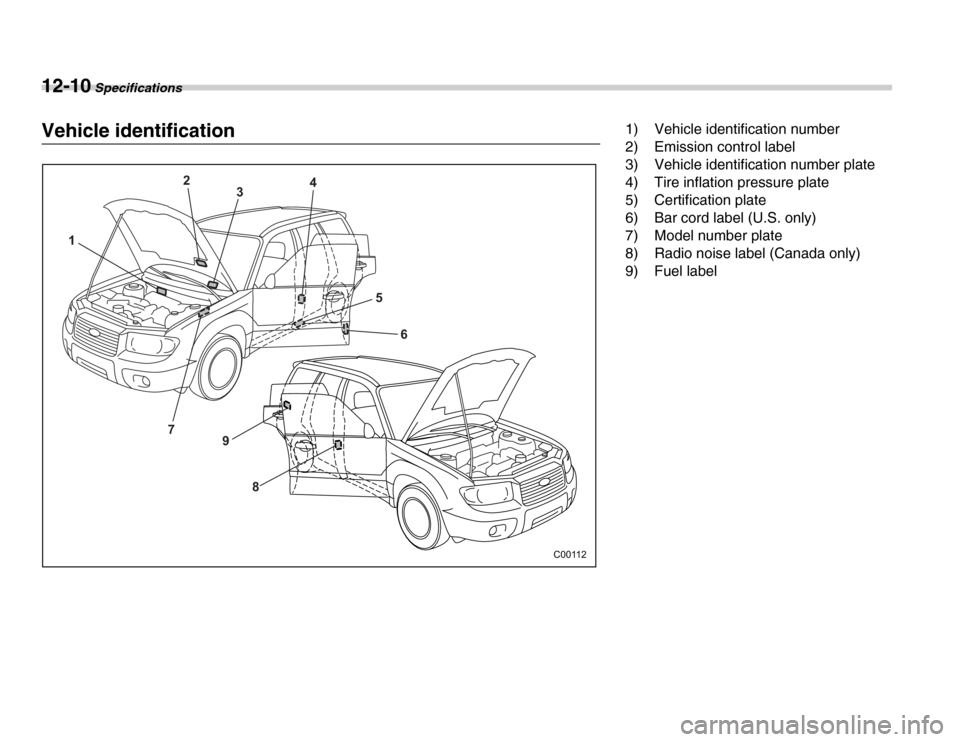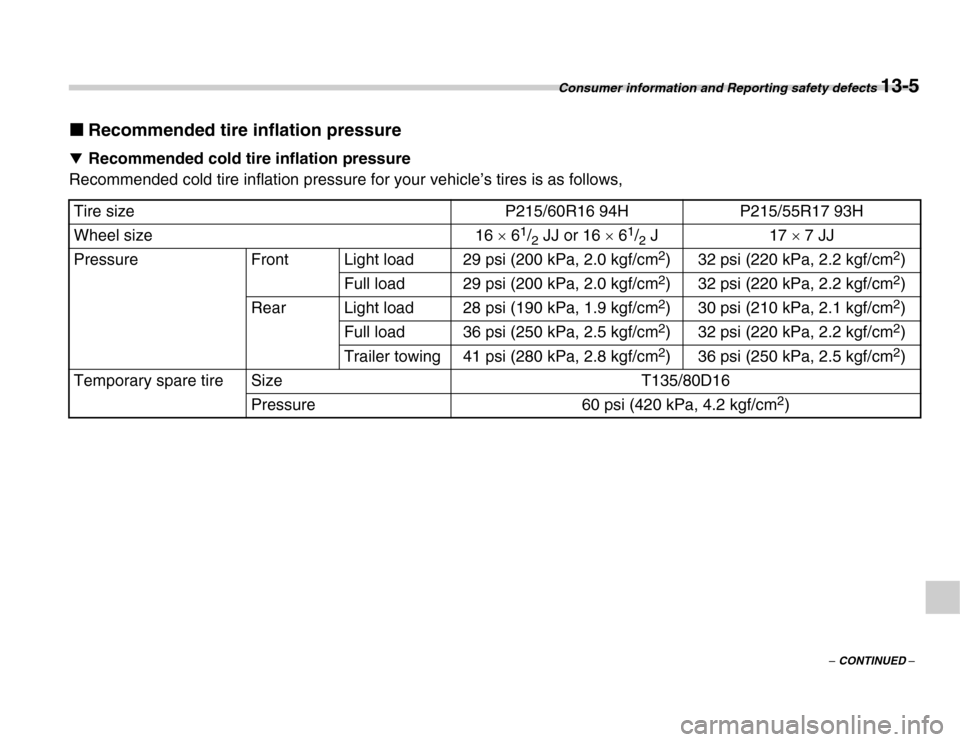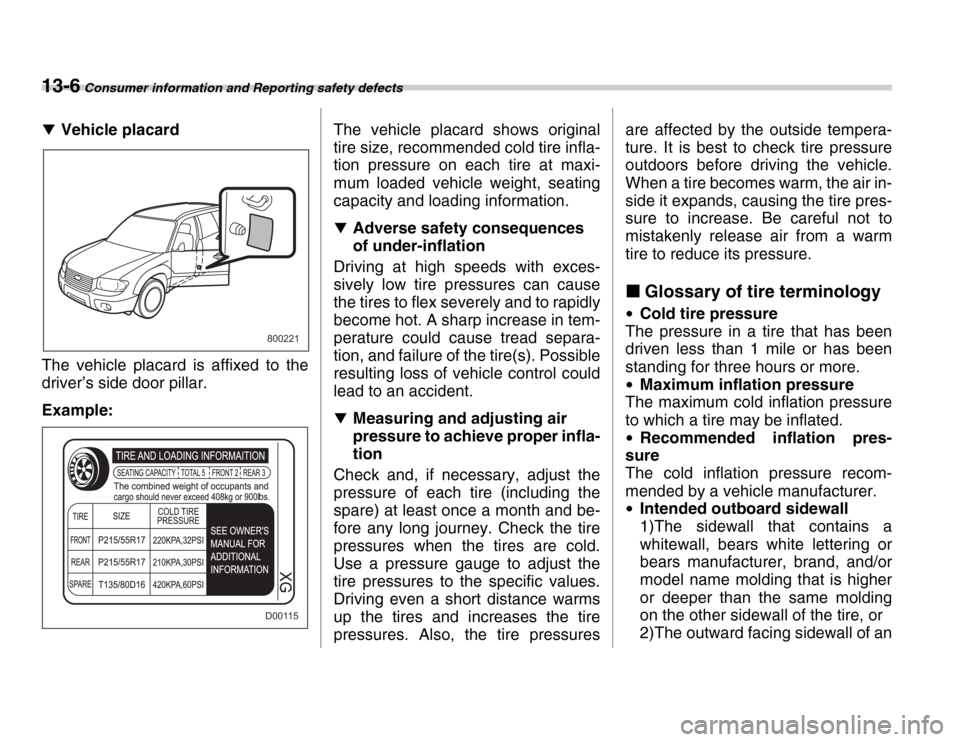inflation pressure SUBARU FORESTER 2007 SG / 2.G Owners Manual
[x] Cancel search | Manufacturer: SUBARU, Model Year: 2007, Model line: FORESTER, Model: SUBARU FORESTER 2007 SG / 2.GPages: 356, PDF Size: 5.89 MB
Page 247 of 356

Driving tips 8-23
– CONTINUED –
Connection of trailer lights to your vehi-
cle’s electrical system requires modifica-
tions to the vehicle’s lighting circuit to in-
crease its capacity and accommodate wir-
ing changes. To ensure the trailer lights
are connected properly, please consult
your SUBARU dealer. Check for proper
operation of the turn signals, the brake
lights and parking lights each time you
hitch up. �T
Tires
Make sure that all the tires on your vehicle
are properly inflated to the pressure spec-
ified on the tire placard located on the driv-
er’s side center pillar.
Trailer tire condition, size, load rating and
proper inflation pressure should be in ac-
cordance with the trailer manufacturer’s
specifications. �„
Trailer towing tips
�TBefore starting out on a trip
�y Check that the vehicle and vehicle-to-
hitch mounting are in good condition. If
any problems are apparent, do not tow the
trailer. �y Check that the vehicle sits horizontally
with the trailer attached. If the vehicle is
tipped sharply up at the front and down at
the rear, check the total trailer weight,
GVW, GAWs and tongue load again, then
confirm that the load and its distribution
are acceptable. �y Check that the tire pressures are cor-
rect. �y Check that the vehicle and trailer are connected properly. Confirm that
– the trailer tongue is connected prop-
erly to the hitch ball.
– the trailer lights connector is connect-
ed properly and trailer’s brake lights illu-
minate when the vehicle’s brake pedal
is pressed, and that the trailer’s turn sig-
nal lights flash when the vehicle’s turn
signal lever is operated.
– the safety chains are connected prop-
erly.
– all cargo in the trailer is secured safe-
ty in position.
– the side mirrors provide a good rear-
ward field of view without a significant
blind spot.
�y Sufficient time should be taken to learn
the “feel” of the vehicle/trailer combination
before starting out on a trip. In an area free
of traffic, practice turning, stopping and
backing up. �T Driving with a trailer
�y You should allow for considerably more
stopping distance when towing a trailer.
Avoid sudden braking because it may re-
sult in skidding or jackknifing and loss of
control. �y Avoid abrupt starts and sudden acceler-
ations. If your vehicle has a manual trans-
mission, always start out in first gear and
release the clutch at moderate engine rev-
Never tow a trailer when the tempo-
rary spare tire is used. The tempo-
rary spare tire is not designed to
sustain the towing load. Use of the
temporary spare tire when towing
can result in failure of the spare tire
and/or less stability of the vehicle.
�y Never exceed 45 mph (72 km/h)
when towing a trailer in hilly coun-
try on hot days.
�y When towing a trailer, steering,
stability, stopping distance and
braking performance will be dif-
ferent from normal operation. For
safety’s sake, you should employ
extra caution when towing a trail-
er and you should never speed.
You should also keep the follow-
ing tips in mind:
Page 252 of 356

9-2 In case of emergency
In c ase of e me rge ncyIf you park your vehicle in
case of an emergency
The hazard warning flasher should be
used in day or night to warn other drivers
when you have to park your vehicle under
emergency conditions.
Avoid stopping on the road. It is best to
safely pull off the road if a problem occurs.
The hazard warning flasher can be acti-
vated regardless of the ignition switch po-
sition.
Turn on the hazard warning by pushing
the hazard warning flasher switch. Turn it
off by pushing the switch again.
NOTE
When the hazard warning flasher is on, the turn signals do not work.
Temporary spare tire (if
equipped)
The temporary spare tire is smaller and
lighter than a conventional tire and is de-
signed for emergency use only. Remove
the temporary spare tire and re-install the
conventional tire as soon as possible be-
cause the spare tire is designed only for
temporary use.
Check the inflation pressure of the tempo-
rary spare tire periodically to keep the tire
300117
Never tow a trailer when the tempo-
rary spare tire is used. The tempo-
rary spare tire is not designed to
sustain the towing load. Use of the
temporary spare tire when towing
can result in failure of the spare tire
and/or less stability of the vehicle
and may lead to an accident.
Never use any temporary spare tire
other than the original. Using other
sizes may result in severe mechani-
cal damage to the drive train of your
vehicle.
Page 332 of 356

12-10 Specifications
Vehicle identification
12
3 4
56
9 8
7
C00112 1) Vehicle identification number
2) Emission control label
3) Vehicle identification number plate
4) Tire inflation pressure plate
5) Certification plate
6) Bar cord label (U.S. only)
7) Model number plate
8) Radio noise label (Canada only)
9) Fuel label
Page 333 of 356

13
Consumer information and Reporting safety defects
Tire information .................................................. 13-2Tire labeling ............................................................. 13-2
Recommended tire inflation pressure .................. 13-5
Glossary of tire terminology .................................. 13-6
Tire care – maintenance and safety practices ..... 13-7
Vehicle load limit – how to determine ................... 13-8
Determining compatibility of tire and vehicle load capacities ...................................................... 13-10
Adverse safety consequences of overloading on handling and stopping and on tires .............. 13-11
Steps for Determining Correct Load Limit ........... 13-11
Uniform tire quality grading standards ............ 13-12 Treadwear ................................................................ 13-12
Traction AA, A, B, C ................................................ 13-12
Temperature A, B, C ............................................... 13-12
Reporting safety defects (USA) ......................... 13-13
Page 335 of 356

Consumer information and Reporting safety defects 13-3
– CONTINUED –
which specifies the maximum load a
tire can carry at the speed indicated
by its speed symbol, at maximum in-
flation pressure.
For example, “94” means 1,477 lbs
(670 kg).
(7) Speed Rating: An alphabetical
system describing a tire’s capability to
travel at established and predeter-
mined speeds.
For example, “H” means 130 mph
(210 km/h)
�T
Tire Identification Number (TIN)
Tire Identification Number (TIN) is
marked on the intended outboard
sidewall. The TIN is composed of four
groups. Here is a brief review of the
TIN with a breakdown of its individual
elements. (1) Manufacturer’s Identification
Mark
(2) Tire Size
(3) Tire Type Code
(4) Date of Manufacture
The first two figures identify the week,
starting with “01” to represent the first
full week of the calendar year; the
second two figures represent the
year. For example, 0101 means the
1st week of 2001.
�T Other markings
The following makings are also
placed on the sidewall. �V Maximum permissible inflation
pressure
The maximum cold inflation pressure
to which this tire may be inflated. For
example, “300 kpa (44 PSI) MAX.
PRESS” �V Maximum load rating
The load rating at the maximum per-
missible weight load for this tire. For
example, “MAX. LOAD 670 kg (1477
LBS) @ 300 kpa (44 PSI) MAX.
PRESS.”
Load indices apply only to the
tire, not to the vehicle. Putting a
load rated tire on any vehicle
does not mean the vehicle can
be loaded up to the tire’s rated
load.
�y Speed ratings apply only to
the tire, not to the vehicle. Put-
ting a speed rated tire on any
vehicle does not mean the ve-
hicle can be operated at the
tire’s rated speed.
�yThe speed rating is void if the
tires are worn out, damaged,
repaired, retreaded, or other-
wise altered from their original
condition. If tires are repaired,
retreaded, or otherwise al-
tered, they may not be suitable
for original equipment tire de-
signed loads and speeds.
DOT XX XX XXX XXXX
(1) (2) (3)(4)
Page 337 of 356

Consumer information and Reporting safety defects 13-5
–
CONTINUED –
�„ Recommended tire inflation pressure
�T Recommended cold tire inflation pressure
Recommended cold tire inflation pressure for your vehicle’s tires is as follows,
Tire sizeP215/60R16 94HP215/55R17 93H
Wheel size16 �u 6 1
/2 JJ or 16
�u 6 1
/2 J17
�u 7 JJ
PressureFrontLight load29 psi (200 kPa, 2.0 kgf/cm 2
)32 psi (220 kPa, 2.2 kgf/cm 2
)
Full load29 psi (200 kPa, 2.0 kgf/cm 2
)32 psi (220 kPa, 2.2 kgf/cm 2
)
RearLight load28 psi (190 kPa, 1.9 kgf/cm 2
)30 psi (210 kPa, 2.1 kgf/cm 2
)
Full load36 psi (250 kPa, 2.5 kgf/cm 2
)32 psi (220 kPa, 2.2 kgf/cm 2
)
Trailer towing41 psi (280 kPa, 2.8 kgf/cm 2
)36 psi (250 kPa, 2.5 kgf/cm 2
)
Temporary spare tireSizeT135/80D16
Pressure60 psi (420 kPa, 4.2 kgf/cm 2
)
Page 338 of 356

13-6 Consumer information and Reporting safety defects
�TVehicle placard
The vehicle placard is affixed to the
driver’s side door pillar.
Example: The vehicle placard shows original
tire size, recommended cold tire infla-
tion pressure on each tire at maxi-
mum loaded vehicle weight, seating
capacity and loading information.
�T Adverse safety consequences
of under-inflation
Driving at high speeds with exces-
sively low tire pressures can cause
the tires to flex severely and to rapidly
become hot. A sharp increase in tem-
perature could cause tread separa-
tion, and failure of the tire(s). Possible
resulting loss of vehicle control could
lead to an accident. �T Measuring and adjusting air
pressure to achieve proper infla- tion
Check and, if necessary, adjust the
pressure of each tire (including the
spare) at least once a month and be-
fore any long journey. Check the tire
pressures when the tires are cold.
Use a pressure gauge to adjust the
tire pressures to the specific values.
Driving even a short distance warms
up the tires and increases the tire
pressures. Also, the tire pressures are affected by the outside tempera-
ture. It is best to check tire pressure
outdoors before driving the vehicle.
When a tire becomes warm, the air in-
side it expands, causing the tire pres-
sure to increase. Be careful not to
mistakenly release air from a warm
tire to reduce its pressure.
�„ Glossary of tire terminology
�y Cold tire pressure
The pressure in a tire that has been
driven less than 1 mile or has been
standing for three hours or more. �y Maximum inflation pressure
The maximum cold inflation pressure
to which a tire may be inflated. �y Recommended inflation pres-
sure
The cold inflation pressure recom-
mended by a vehicle manufacturer. �y Intended outboard sidewall
1)The sidewall that contains a
whitewall, bears white lettering or
bears manufacturer, brand, and/or
model name molding that is higher
or deeper than the same molding
on the other sidewall of the tire, or
2)The outward facing sidewall of an
800221
D00115